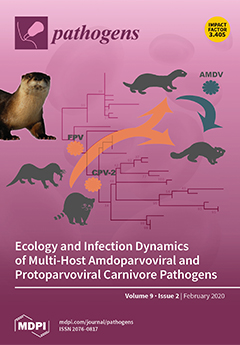Staphylococcus aureus is an opportunistic bacterium causing a wide variety of diseases. Biofilm formation of
Staphylococcus aureus is of primary public and animal health concern. The purposes of the present study were to investigate the ability of
Staphylococcus aureus isolated from animals, humans, and food samples to form biofilms and to screen for the presence of biofilm-associated and regulatory genes. In total, 55
Staphylococcus aureus isolated from sheep mastitis cases (
n = 28), humans (
n = 19), and from food matrices (
n = 8) were identified using matrix-assisted laser desorption/ionization time-of-flight mass spectrometry (MALDI-TOF MS). The ability of
Staphylococcus aureus for slime production and biofilm formation was determined quantitatively. A DNA microarray examination was performed to detect adhesion genes (
icaACD and biofilm-associated protein gene (
bap)), genes encoding microbial surface components recognizing adhesive matrix molecules (MSCRAMMs), regulatory genes (accessory gene regulator (
agr) and staphylococcal accessory regulator (
sarA)), and the staphylococcal cassette chromosome
mec elements (SCC
mec). Out of 55
Staphylococcus aureus isolates, 39 (71.0%) and 23 (41.8%) were producing slime and biofilm, respectively. All
Staphylococcus aureus strains isolated from food showed biofilm formation ability. 52.6% of the
Staphylococcus aureus strains isolated from sheep with mastitis, and 17.9% of isolates from humans, were able to form a biofilm. Microarray analysis typed the
Staphylococcus aureus into 15 clonal complexes. Among all
Staphylococcus aureus isolates, four of the human isolates (21.1%) harbored the
mecA gene (SCC
mec type IV) typed into 2 clonal complexes (CC22-MRSA-IV and CC80-MRSA-IV) and were considered as methicillin-resistant, while two of them were slime-producing. None of the isolates from sheep with mastitis harbored the
cna gene which is associated with biofilm production. The
fnbB gene was found in 100%, 60% and 40% of biofilm-producing
Staphylococcus aureus isolated from food, humans, and sheep with mastitis, respectively. Three
agr groups were present and
agr group III was predominant with 43.6%, followed by
agr group I (38.2%), and
agr group II (18.2%). This study revealed the capacity of
Staphylococcus aureus isolates to form biofilms and highlighted the genetic background displayed by
Staphylococcus aureus isolates from different sources in Algeria.
Full article






